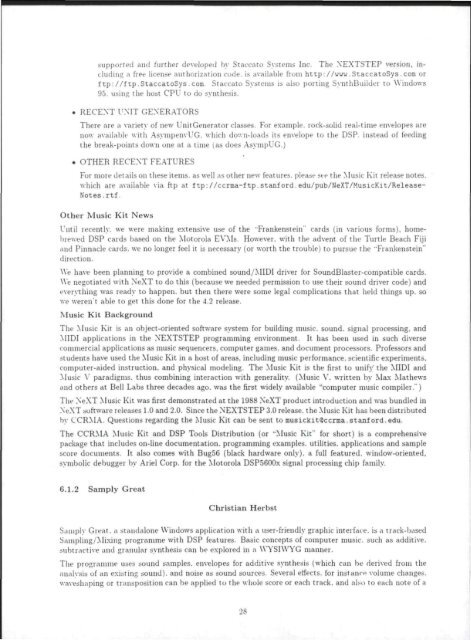Download - CCRMA - Stanford University
Download - CCRMA - Stanford University
Download - CCRMA - Stanford University
You also want an ePaper? Increase the reach of your titles
YUMPU automatically turns print PDFs into web optimized ePapers that Google loves.
supported and further developed by Staccato Systems Inc. The NEXTSTEP version, including<br />
a free license authorization code, is available from http://wuv.StaccatoSys.com or<br />
ftp://ftp.StaccatoSys.com. Staccato Systems is also porting SynthBuilder to Windows<br />
95. using the host CPU to do synthesis.<br />
. RECENT UNIT GENERATORS<br />
There are a variety of new UnitGenerator classes. For example, rock-solid real-time envelopes are<br />
now available with AsympenvUG. which down-loads its envelope to the DSP. instead of feeding<br />
the break-points down one at a time (as does AsympUG.)<br />
. OTHER RECENT FEATURES<br />
For more details on these items, as well as other new features, please si-e the Music Kit release notes,<br />
which are available via ftp at ftp://ccrma-ftp.stanford.edu/pub/NeXT/MusicKit/Release-<br />
Notes.rtf.<br />
Other Music Kit News<br />
Until recently, we were making extensive use of the "Frankenstein" cards (in various forms), homebrewed<br />
DSP cards based on the Motorola EYMs. However, with the advent of the Turtle Beach Fiji<br />
and Pinnacle cards, we no longer feel it is necessary (or worth the trouble) to pursue the "Frankenstein"<br />
direction.<br />
We have been planning to provide a combined sound/MIDI driver for SoundBlaster-compatible cards.<br />
We negotiated with NeXT to do this (because we needed permission to use their sound driver code) and<br />
everything was ready to happen, but then there were some legal complications that held things up. so<br />
we weren't able to get this done for the 4.2 release.<br />
Music Kit Background<br />
The Music Kit is an object-oriented software system for building music, sound, signal processing, and<br />
MIDI applications in the NEXTSTEP programming environment. It has been used in such diverse<br />
commercial applications as music sequencers, computer games, and document processors. Professors and<br />
students have used the Music Kit in a host of areas, including music performance, scientific experiments,<br />
computer-aided instruction, and physical modeling. The Music Kit is the first to unify' the MIDI and<br />
Music V paradigms, thus combining interaction with generality. (Music V. written by Max Mathews<br />
and others at Bell Labs three decades ago. was the first widely available "computer music compiler.")<br />
The NeXT Music Kit was first demonstrated at the 1988 NeXT product introduction and was bundled in<br />
NeXT software releases 1.0 and 2.0. Since the NEXTSTEP 3.0 release, the Music Kit has been distributed<br />
by <strong>CCRMA</strong>. Questions regarding the Music Kit can be sent to musickitOccrma.stanford.edu.<br />
The <strong>CCRMA</strong> Music Kit and DSP Tools Distribution (or "Music Kit" for short) is a comprehensive<br />
package that includes on-line documentation, programming examples, utilities, applications and sample<br />
score documents. It also comes with Bug56 (black hardware only), a full featured, window-oriented,<br />
symbolic debugger by Ariel Corp. for the Motorola DSP5600x signal processing chip family.<br />
6.1.2 Samply Great<br />
Christian Herbst<br />
Samply Great, a standalone Windows application with a user-friendly graphic interface, is a track-based<br />
Sampling/Mixing programme with DSP features. Basic concepts of computer music, such as additive,<br />
subtractive and granular synthesis can be explored in a WYSIW r YG manner.<br />
The programme uses sound samples, envelopes for additive synthesis (which can be derived from the<br />
analysis of an existing sound), and noise as sound sources. Several effects, for instance volume changes,<br />
waveshaping or transposition can be applied to the whole score or each track, and also to each note of a<br />
J>

















